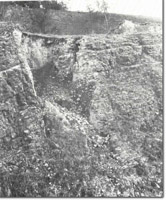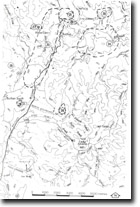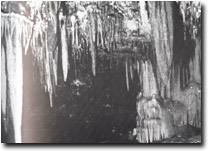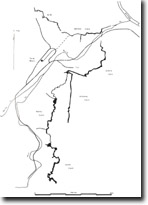8523 (8522)-23 The Buchan Caves Area
Sites 8523 (8522) 16 to 30 - The Buchan/Murrindal Limestone Basin
This information has been developed from the publications:
|
Location: | 026497. 1 kilometre south-west of Buchan township. |  Cutting on access road to Buchan Caves Reserve. Taradale Formation mudstones and nodular limestones subject to rapid mass wasting. |
Abstract: | Type site for Buchan Cave Limestone. Best known and well decorated passage caves. | |
Access: | Caves Reserve Road. | |
Ownership: | Crown land reserve and some private land. | |
Geology: | The limestone outcrop which includes the Buchan Caves exhibit’s the full range of sediment types in the Buchan Caves Limestone Formation which in this area reaches a thickness of 370 m. The limestone in general conformably overlies the Snowy River Volcanics and is separated from the latter by transition beds consisting of sandstone, grits and limestones interbedded with tuffaceous layers. These transition beds (the Spring Creek Member) are exposed in Spring Creek and Eighty Acre Creek. The Spring Creek Member is followed by 30-40 m of dolomite and dolomitic limestone which are generally poorly fossiliferous. The dolomitic beds are followed by mid-grey to black, fine to medium grained calcar nite, with a high proportion of black calcirudite in the upper part of the formation. Above the dolomitized sediments the limestone becomes increasingly fossiliferous. The brachiopod, Acrospirifer occurs lowest down in the sequence and is often found concentrated in well defined limestone beds. Slightly higher up the sequence Campophyllum recessum appears and occurs in alternating beds with Acrospirifer. These two fossil species are characteristics of the middle part of the Buchan Caves Limestone. Within this middle zone some 3 m above the lowest Acrospirifer horizon, a bed unusually rich is outraced outcrops in Fairy Creek, just south of the Caves Reserve boundary. This bed contains Aparchites regularis, A. bushiness, Schimidtella subfabiformis, Sulcella australis and Kloedenella indistincta. Ostracods are generally more characteristic of the upper part of the limestone sequence where they occur in association with pelcypods and nautili’s. The uppermost 30-40 metres of the limestone sequence is richly fossiliferous with over 30 species of brachiopods, molluscs and corals. The Buchan Caves Limestone is conformably overlain by the Taravale Formation. The latter is well exposed in a road cutting at the entrance to the Caves Reserve. At this locality, the Taravale Formation consists of interbedded mudstones containing various amounts of impure limestone nodules. This formation is particularly susceptible to mass wasting which is well exhibited in the cutting. | |
Geomorphology: | Well developed surface karst features do not occur within this area. However, this area is of great significance for its cave development with 75 known caves. It includes the most extensive cave system in Victoria, consisting of Dukes Cave (B-7), Fairy Cave (B-5), Royal Cave (B-6), Federal Cave (B-7) and caves (B-64) and (B-65). This cave system contains between 4 and 5 kilometres of stream passage cut at several levels including areas where it is widened into caverns by block collapse. Some of the best cave decoration known in Victoria is found in these caves. It includes well developed stalactite and stalagmite forms, pillars, shawls, speleothems, rim pools and helicites together with cave sediments and a permanent flowing stream. Other caves of importance in this area; Moons Cave (B-2), Spring Creek Cave (B-1), Kitsons Cave (B-8, B-16), Whale Cave (B-20, B-57), Scrooges Vault and System (B-56, B-67, B-39, B-40, B-41) and Archivolt Cave, (unnumbered). Moon Cave (B-2) was previously used as a tourist cave and consists of a stream passage which is well developed in parts and which contains a permanent stream. The water source of the stream is unknown although it is thought that B-32 Dave feeds into Moons Cave. It is postulated that additional water enters the system from the Buchan River. Moons Cave is polluted by sewage effluent from the Caravan Park toilet block. Spring Creek Cave (B-1) consists of a horizontal maze system developed along joint planes and represents an early phase of cave development. This cave is currently dry and contains bats and vertebrate bone deposits. Kitson Cave (B-8) varies from those described above as its from is controlled by bedding and has developed partially down dip. A similar cave is Whale Cave (B-20, B-57) which has developed on several levels and contains extensive areas of mud slope and ends in a stream passage. Scrooges Vault System includes 5 caves all of which are water-course connected. This is a complex system and the low levels act as a water reservoir collecting water from sources to the south. In addition Scrooges Vault is noteworthy for its excellent cave decoration which includes speleothems and calcite rafts. | |
Significance: | National. This area contains the most extensive cave system known in Victoria and is the type area for the Buchan Caves Limestones. | |
Management: | Land use allocation without adequate knowledge of the hydrology of the cave systems has already degraded parts of this important resource. Hydrological studies are in progress on this system, and until these are completed it is not appropriate to recommend detailed management prescriptions for the area. The general recommendations outlined are applied to this locality. The scientific value of the cave is dependent on the maintenance of a stable hydrological system and a high level of water quality. The present Caves Reserve includes only a part of the limestone outcrop in this area and consequently excludes several important caves and probably the major part of the catchment of the Reserve Caves system. It is thus recommended that the Caves Reserve be extended to include the headwaters of Fairy Creek. | |
References: | Stirling, J. 1887. 'The physiography of the Tambo Valley', Ibid, 1(2) :37-66. Kitson, A.E. 1907. 'Proposed reservation of limestone caves in the Buchan District, Eastern Gippland', Rec. geol. Surv. Vict., II(I) :37-44. Dunn, E.J. 1909. 'The Serpentine area, Wellington River, Gippsland', Rec. geol. Surv. Vict., 3 :65. Swift, 1950 Tiechert, C. and Talent, J.A. 1958. 'Geology of the Buchan area, East Gippsland', Mem. geol. Surv. Vict., 21: 1-56. Sweeting, M.M. 1960. 'The caves of the Buchan area, Victoria, Australia', Z. Geomorph. Suppl., 2 :81-89. Matthews, P.G. (ed) 1968. Speleological Handbook. Victorian Speleological Association. Nicoll R.S. and Brush, J.B. 1976. Guidebook to the caves of South Eastern N.S.W. and Eastern Victoria. A.S.F. Guidebook No.1. White, N.J. and Davey, A. 1977. 'Pollution of Moons Cave, Buchan, Victoria : A Case Study in Cave Reserve Management', Proc. 11th Biennial Conference, Australian Speleological Federation. Canberra, 1976. O'Shea, P.J. 1980. 'Mineral Potential of the Snowy River Volcanics and Buchan Caves Limestone', Rep. Geol. Surv. Vict., No.63. | |
 8523 (8522)-20 to 8523-21, 23-24, 26-31 |  Buchan Caves. Cave decoration. |



